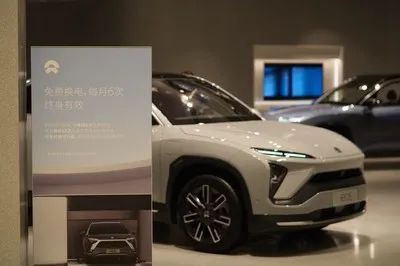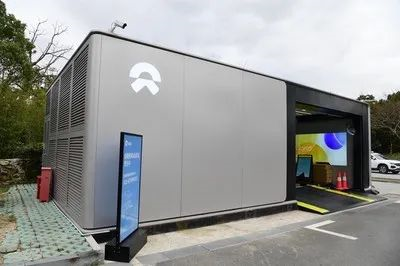This article is authorized by ChuxingyiKe (Wechat ID: carcaijing), created by Caixin Transportation Industry Group and written by Yang Li, edited by Zhiliang Shi.
Both super fast charging and battery swapping are choices for car companies and consumers, with no inherent advantages or disadvantages. The only concern is infrastructure costs, which can be borne by the enterprise.
Ten years ago, State Grid Corporation of China introduced battery swapping, but the idea failed to catch on. Ten years later, battery swapping once again faced questioning as a new darling in the new energy industry-led new infrastructure.
The concept of electric vehicle battery swapping refers to a business model where a large number of batteries are centrally stored, charged, and uniformly distributed through centralized charging stations, and battery replacement services are provided to electric vehicles at battery distribution stations.
In May 2020, battery swapping stations were first written into the government work report as an important part of new infrastructure, expanding “building charging piles” to “adding charging facilities, battery swapping stations, and other facilities”. On July 23 of the same year, at a State Council press conference, the Ministry of Industry and Information Technology gave a detailed positive interpretation of the new energy battery swapping mode, which meant that battery swapping would have a broader development prospect.
The facts are consistent with the policy orientation. State-owned automakers such as Changan, Dongfeng, and SAIC have rushed into the battery swapping camp, and new automakers such as XPeng and NIO have also begun to move towards the battery swapping mode. As a leading power battery company, CATL has also actively cooperated with automakers to establish battery management asset companies and joined the wave of battery swapping.
As for BAIC New Energy, which first laid out the battery swapping mode, it has signed a cooperation agreement with State Grid Corporation of China to study battery procurement, leasing, operation, hierarchical utilization, and recycling under the battery swapping and vehicle-electricity separation commercial mode and has developed a full life cycle management and operation plan for batteries.
Obviously, since the new energy vehicle battery swapping mode was backed by the Ministry of Industry and Information Technology and other departments, the concept of battery swapping has been accepted by the market and has quickly become a new trend. Among them, NIO alone added 605 battery swapping stations in 2021, bringing the total number of swapping stations to 777.
However, this round of battery swapping trend led by car companies has been questioned by many opinions, whose core logic is that without battery standardization, the battery swapping mode is not feasible. If there are so many types of gasoline for fossil-fuel-powered cars, such as 95, 97, and 98, is it really impracticable to have a national standardized battery swapping mode?
It should be noted that battery swapping vehicles also have charging capabilities. An industry consensus is that the most important way to supplement energy for electric vehicles in the future is actually to use home charging piles, which can meet more than 90% of the travel scenarios. The so-called battery swapping and super-fast charging only meet the energy supplement needs of a small number of extreme situations.Currently, super fast charging puts extreme strain on the power grid and cannot be intensively constructed in the short term. Similarly, standardized battery swap stations also cannot be widely popularized in the short term. However, this does not hinder both from becoming options for car companies and consumers.
Because both super fast charging and battery swapping are non-mainstream ways of supplementing energy, they complement the insufficiency of home charging piles. They do not need to be widely popularized, but rather reasonably arranged to meet demands.
Taking NIO as an example, as long as all NIO vehicles use a unified standard, NIO battery swap stations can serve all NIO car owners without being affected by different battery standards from Tesla and BYD. Both fast charging and battery swapping are options for car companies and consumers, and they do not inherently have advantages or disadvantages.

What’s Different Ten Years After Restarting Battery Swapping Mode?
Battery swapping is not a business model that has only recently emerged. In the early days of China’s new energy vehicle industry development, swapping and charging were in opposition in terms of development paths.
Liu Zhenya, then the general manager of State Grid Corporation of China, loudly announced at the company’s 2011 work conference that State Grid had determined the basic commercial operation model for electric vehicles as primarily battery swapping, supplemented by plug charging, centralized charging, and unified distribution.
At that time, State Grid’s “peak-valley-adjustment” strategy was very clear: building charging and swapping stations near substations could avoid significant impact on the distribution network. Meanwhile, in city centers where land resources are scarce or the power grid is difficult to expand or remodel, battery charging stations could be built near suburban substations. This successfully solved the two major bottleneck problems of land resources and the distribution network.
However, the ideal was full, but the reality was skinny. The “peak-valley-adjustment” strategy not only failed to receive sufficient response from the industry, but also faced great questioning from within the industry.
Miao Wei, then Minister of Industry and Information Technology, stated in an interview with Commercial Vehicle News that the new energy vehicle industry would not be led by electric power companies. Wang Binggang, the then-head of the National New Energy Vehicle Innovation Engineering project, who is still alive today, pointed out that the Chinese people, who attach great importance to the integrity of private property, could not accept the consumption method of constant battery swapping. Moreover, almost all automakers expressed doubt about the battery swapping model.
Looking back, the biggest reason why the battery swapping model failed at the time was that its commercial foundation relied on the unified standard specifications for power batteries. However, the new energy industry was just sprouting at that time, and the entire upstream and downstream were exploring ways to develop the industry. It’s only through open, try-err-repeat multiple-line development that the correct path can be found. With great uncertainty in both technological direction and economic benefits, how could the battery swapping model lead the development of the new energy industry?However, over the past decade, the development trajectory of new energy vehicles has gradually become clear. Meanwhile, the bottleneck of charging stations has become more and more prominent, even with the 800V super fast charging, it has its own limitations. Under the current technological conditions, only battery swapping can match fuel vehicles in terms of convenience.
As more and more new energy vehicles appear on the roads, the efficiency advantage of battery swapping becomes more and more prominent. This is the fundamental reason why battery swapping is being restarted ten years later. Meanwhile, battery swapping also has many advantages.
Firstly, the battery charging and maintenance are handled by the battery stations, which means that the power battery will be monitored, maintained and managed by professionals, advantageous for extending battery life. More importantly, vehicle owners can avoid the most dangerous period for electric vehicles- charging (currently, most battery fires occur during charging).
Secondly, it reduces the cost of purchasing the vehicle for the consumers. On the one hand, the popularization of the battery swapping model is conducive to the development of the ladder utilization of the power battery, reducing the overall lifecycle cost of the battery; on the other hand, vehicle battery separation can provide richer business models, such as buying cars and renting batteries, greatly reducing the threshold for purchasing a vehicle.
Finally, through distributed energy storage, peak shaving, and valley filling, the burden on urban power grids is reduced. At the same time, the higher efficiency of charging stations is advantageous for urban planning. According to Huang Chunhua, the general manager of the Oudong New Energy Marketing Center, the Oudong 3.0 battery swapping station covers an area of about 200 square meters and is more than 50 times more efficient than a charging pile of the same area.
Therefore, unlike the battery swapping model that was primarily promoted by the State Grid for peak shaving ten years ago, this wave of new infrastructure battery swapping is being pushed by vehicle and battery companies based on real market demand.
Constrained by standardization, is battery swapping feasible?
Undeniably, the battery swapping model has significant value for the promotion and development of current electric vehicles, but its drawbacks are also evident: the standardization of battery specifications is always a major obstacle to the battery swapping model.
It is not realistic for a single enterprise to carry out the battery swapping model alone. Only after each enterprise reaches a unified standard, that is, enabling multi-brand battery swapping, can the battery swapping model mature. However, involving the unification of product specifications, the gains and losses among various enterprises are difficult to balance.
Therefore, not all vehicle companies are enthusiastic about participating in the battery swapping model. BYD, which is both a battery and a vehicle enterprise, stated that “battery swapping is currently involved, including listening to and participating in industry associations, exchange meetings, etc. The technical difficulties of the battery swapping are not great. The main issue is the formulation of standardization and the standardized production of battery manufacturers.”Obviously, before the standardization of battery specifications, many automakers still adopt a wait-and-see attitude towards the battery-swapping mode. Based on this situation, Luo Huanta, President of Dadi Times (Shenzhen) Information Consulting Co., Ltd., told Carcaijing (ID: carcaijing) that the public transportation and rental industries, fixed locations, are moving towards standardization, and the battery swapping mode has the potential to grow, but in the C-end consumer market, it is unlikely to become widespread in the short term.
Cui Dongshu, Secretary-General of the China Passenger Car Association, also stated that the inclusion of battery swapping stations in the new infrastructure will strongly promote the development of battery swapping in the public sector, such as taxis and ride-hailing, but in the private vehicle sector, charging will still be the main direction in the future.
Even Huang Chunhua, the operator of the largest battery swapping station company in China, acknowledged to Carcaijing (ID: carcaijing) that the transition from To B to To C for the battery-swapping model requires gradual progress. Only when the battery swapping stations are densely deployed through To B, the battery models become increasingly diverse (providing more choices for individual users), and the battery standards are gradually unified, can the business truly face To C.
The era of battery swapping transitioning to To C is approaching, and this does not require a unified national battery standard. Just like how gasoline-powered cars can use multiple models of gasoline such as 95, 97, and 98, in battery-swapping technology, current battery swapping stations can already serve multiple vehicle models simultaneously.
Huang Chunhua told Carcaijing (ID: carcaijing), “A single Oudong 3.0 battery swapping station covers an area of about 200 square meters, with 28 batteries in circulation, and can swap a battery in 3 minutes. It can provide services up to 420 times a day. Through the battery warehouse management and self-developed locking mechanism technology, it can also replace batteries for different vehicle models.”
As the number of new energy vehicles rapidly increases, the ownership of certain single-branded vehicles is enough to support the operation of battery-swapping stations, let alone that a single station can serve multiple vehicle models.
Obviously, although standardization is a prerequisite for the large-scale popularity of battery swapping stations, small-scale construction and servicing of battery swapping stations for individual brands do not necessarily require national battery standardization.
More importantly, battery-swapping vehicles also have charging functions, and battery swapping is just a supplement to charging. NIO stressed to Carcaijing (ID: carcaijing), “In terms of energy supplementation, battery swapping supplements charging, and NIO does not set up a conflict between charging and battery swapping.”
As long as NIO-branded vehicles use a unified standard, NIO battery swapping stations can serve all NIO car owners without being limited by other vehicle model standards. In the future, as the number of vehicles with battery swapping functions increases, NIO battery swapping stations can also use the aforementioned battery warehouse management and locking mechanism technology to serve other brands of electric vehicles.
Both super-fast charging and battery swapping are choices for automakers and consumers, and neither method is superior to the other. What can be determined is that for a long time in the future, slow-charging will remain the main power supplement for new energy vehicles, while fast-charging and battery swapping will serve as complementary methods.
This article is a translation by ChatGPT of a Chinese report from 42HOW. If you have any questions about it, please email bd@42how.com.
